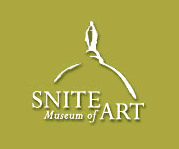
If you have visited the Snite Museum of Art during the past few years, you might have seen exhibits on capital punishment, the environment and gender issues, along with 2,000-year-old stone figures from Mexico, photographs of Tennessee, and Rembrandt etchings.
That mix exemplifies the social conscience that underlies the mission of the museum as it marks its 25th anniversary of service to the campus and community, and one of the measures by which the Snite has grown to be acknowledged among the nations finest university museums.
Since opening in 1980, the Snite collection has increased from 8,000 mostly modest art objects to 23,000 items. The Snites curators have shifted the focus of the collection away from aiming to be encyclopedic, instead strengthening key collections, says Charles Loving, director since 2000.
Loving recalls having a conversation with an art scholar who said the Snites Olmec collection of Mesoamerican art was the best in the nation.I corrected him,says Loving.’You mean the finest at a university.He said, ’I mean the finest in any American museum.
The Snites acclaimed photography collection includes 10,000 images, up from a single photograph in 1974,and that was on the back of another artwork,says Dean Porter, Snite director from 1974 to 1999. It also features a notable collection of 19th century photographs as well as its Old Masters drawings and paintings and 18th and 19th century collections, which also are widely recognized, as is its Ivan Metrovisculpture collection.
By emphasizing areas where we have genuine strength, we have attracted scholars and researchers,says Loving.These collections also attract additional gifts.
In 1999, then-director Porters exhibit,Taos Artists and their Patrons,traveled the country in partnership with the Phoenix Art Museum.It was a high-water mark in original research and knowledge,Loving says. Since then, pieces from the photo collection have traveled in a national show titledA Gift of Lightand the Snite routinely lends single and small groups of objects to other museums.
As an exhibit space, the Snite is enjoyed annually by some 57,000 visitors, who see visual representations of a mission to nourish and challenge the human spirit and enhance understanding of world cultures.
“Its a mission that fits a Catholic university art museum well,” Loving says.Inspiring religious images are prominent in the Snite, he says,but Notre Dame also has a social conscience and a faith-based belief in service to the community that not many university art museums have.
As examples, he mentions museum tours for area schoolchildren (7,000 annually), award-winning after-school and summer art programs at the Robinson Community Learning Center, art camps for at-risk children, and teacher workshops. Supporting the Universitys mission to foster diversity was a show in the museum’s works-on-paper gallery by African American artists, as well as the permanent collection of Mesoamerican, Native American and African art.
The 2003 exhibitGirl Culture: Lauren Greenfield Photographs,depicting issues of body image and fashion in teen girls, solidified the Snites commitment to use exhibits to raise social issues. Student response remains on the minds of the staff.We had students with eating disorders coming in from the counseling center. They said how important the message was.
Loving intends to offer more exhibits with social messages.Our goal is to have a positive influence on individual lives,he says.
The student body is already a built-in presence at the museum, with 3,000 students annually participating in curriculum-related tours and exhibits tailored to particular faculty and their classroom goals. Among such efforts, about 600 students in Spanish language courses receive tours in Spanish. The Snite Essay Competition, based on essays written about art objects, encourages scholarship, and museum benefactors fund two art history graduate internships, as well as one for a graduate graphic design student.
“Its our job to train the next generation of museum curators,Loving says. One Snite intern is now a curator at the J. Paul Getty Museum.
Its also Lovings job to continue improving the museum and welcoming visitors. Its a frustrating task at times, he says, because galleries and storage space are inadequate, restricting the growth of the collection. Some traveling shows pass up the Snite because it lacks a loading dock, and some visitors pass by because theres no nearby parking. Even the annual Christmas benefit dinner had to move off-site three years ago due to lack of space.
Thus, we have Lovings dream for the Snites second 25 years: A 140,000-square-foot building (twice the current size), constructed on a site southeast of the new performing arts center. Loving also desires a public plaza and sculpture park to promote reflection, meditation and prayer. These plans have been formally outlined and financial support is being sought.
Imagine a time,Loving says,when you could park conveniently, enjoy an interesting meal, walk across the street to the museum for a new exhibition and then stroll over to a concert at the performing arts center.
Such a public space would attract and retain the nations brightest and most creative individuals, who would fuel research, business and economic growth, Loving says. He is eager for the Snite to play a role in that new cultural community.
TopicID: 14806